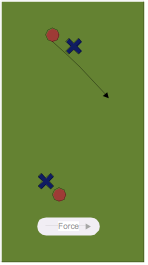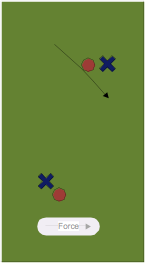I don’t remember ever thinking “It’s time for a layout block” or “I need to be in a position to get a layout block on this throw.” My goal was simply to be in the best position I could be in to cover the person who was my responsibility at the time. I believe that layout blocks are simply ‘opportunities taken’—being in the right place at the right time, and the offense made just enough of a mistake for you to go get it. However, there are a few situations where simple choices can put you in a slightly better position for that elusive layout block. I’ll describe one of the common ones here.
Defensive positioning is often about angles. As the defender, you want to own the better angle to the disc after it is thrown. So, here’s the situation: You are covering an upfield cutter who makes a cut on an angle towards the open side of the field, as shown in figure 1. This cut does happen in both vertical and horizontal stacks, although the angle may be less when the cut is in the horizontal stack.

As the cutter makes the cut, you the defender may become increasingly out of
position. You’ll be on the outside of the receiver and then the receiver owns
the angle.

Many of the layout blocks that I’ve gotten, have been in this situation.
Instead of staying on the outside or trying to stay in front of the receiver,
I slide back a step and take the inside. I do this after the angle of the
throw gets to be to the receivers advantage if I stay on the ‘force side.’

When the throw goes up, you the defender are now in position to make that
layout block—you own the angle. The same theory applies to other situations on
the field.